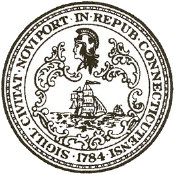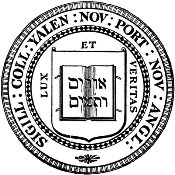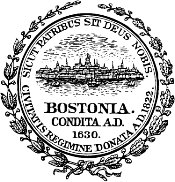
About Andrew Cusack
 Writer, web designer, etc.; born in New York; educated in Argentina, Scotland, and South Africa; now based in London.
Writer, web designer, etc.; born in New York; educated in Argentina, Scotland, and South Africa; now based in London. read more
News
Blogs
Reviews & Periodicals
Arts & Design
World
France
Mitteleuropa
Knickerbockers
Argentina
The Levant
Africa
Cape of Good Hope
Netherlands
Scandinavia
Québec
India
Muscovy
Germany
Academica
Novanglian Peregrinations
A journey to the shining city of Saint Botolph, and return
THE PERIOD OF MY removal to South Africa sometimes inclines me to think that time stood still during my absence from the northern hemisphere. It is as if the mental chronicle of my brain simply ceased, and took up writing in a different book, and then went back to the end of the old page upon my return. But time indeed did pass, and many were the old friends and acquaintances with whom we had not combined in some time. Communication was no better than intermittent while exiled in southerly climes, but, freshly returned, the tom-toms were beat and the smoke signals sent to the usual suspicious characters of note. A convocation of cohorts and old confederates was then proposed, to take place in Boston — caput and urbs maxima of God’s own province of New England.
 My first stop was actually New Haven, and traversing the border into Connecticut I crossed myself in accordance with ancient custom, invoking the guardian angel of that jurisdiction in the usual pleas for safe travel, easy passage, and the avoidance of traffic cops & parking fines. In New Haven, I attended the meeting of a learned society (composed of both postgraduates & undergraduates) devoted to polite discourse, under the sacred patronage of the Saints Augustine of Hippo and of Canterbury, and the secular patronage of the Anglo-Irish divine Bishop Berkeley. Speaking of the divine, the society’s meeting was preceded by Mass, offered by one of the Dominicans who unofficially tend to the flock of Yale students (the official Roman chaplaincy there having a poor reputation) in an improvised chapel at the club’s quarters.
My first stop was actually New Haven, and traversing the border into Connecticut I crossed myself in accordance with ancient custom, invoking the guardian angel of that jurisdiction in the usual pleas for safe travel, easy passage, and the avoidance of traffic cops & parking fines. In New Haven, I attended the meeting of a learned society (composed of both postgraduates & undergraduates) devoted to polite discourse, under the sacred patronage of the Saints Augustine of Hippo and of Canterbury, and the secular patronage of the Anglo-Irish divine Bishop Berkeley. Speaking of the divine, the society’s meeting was preceded by Mass, offered by one of the Dominicans who unofficially tend to the flock of Yale students (the official Roman chaplaincy there having a poor reputation) in an improvised chapel at the club’s quarters.
Mass was followed by port, smoking, and some cheese & finger foods for the hungry souls. I mentioned to a friend that the Choco-Leibniz cookies on offer were my favourite, the official state biscuit of the house of Cusack. “Of course they are,” the wag responded. “Choco-Leibniz are the best of all possible biscuits!” (Some jokes are so bad that the resulting chortles are both inevitable and involuntary.)
Then, the subject at hand. This meeting was convened to discuss the recently announced Apostolic Constitution establishing “personal ordinariates” to ease the reception of Anglican Christians into full visible communion with the Pope. The assembled members were by no means only Catholics, but with a significant portion of Episcopalians, and the odd Calvinist for good measure. A brief paper by an entrenched Anglican was read, and the members responded and discussed the matter with courtesy and depth as the fire crackled in the background. Which groups are likely to take advantage of the coming ordinariates? Which are least likely? Was this chiefly a pastoral move? What do the Orthodox think? What will the reaction be outside North America? All these questions and many, many more were raised and, so far as possible, answered.
 The formal discussion was concluded with the invocation of the two Augustines and a toast to Bishop Berkeley. A number of members remained by the fire while others dispersed for other events. The weekend beheld the 75th Anniversary of the Yale Political Union, and so the constituent parties of the YPU were all having events for their members and alumni. (From what I can understand of the YPU’s right-leaning parties, the Conservative Party is for Republicans, the Tory Party is for decadent Anglophiles, and the Party of the Right is for conservatives.)
The formal discussion was concluded with the invocation of the two Augustines and a toast to Bishop Berkeley. A number of members remained by the fire while others dispersed for other events. The weekend beheld the 75th Anniversary of the Yale Political Union, and so the constituent parties of the YPU were all having events for their members and alumni. (From what I can understand of the YPU’s right-leaning parties, the Conservative Party is for Republicans, the Tory Party is for decadent Anglophiles, and the Party of the Right is for conservatives.)
Following the procurement of beer and the ordering of pizza, the consumption of both, and the extinguishing of the fire, it was time to retreat for the evening to the splendid old Victorian house where a number of folks live. It’s one of those old, solidly American homes, with a swinging chair on the porch, splendid wood detailing inside, and pocket doors between the receiving rooms. Dotted around an old dining room table, more news and rumours were exchanged between the inhabitants and guests as the remnants of a bottle of Macallan was polished off. The Choco-Leibniz joke was repeated for those who were not in attendance before. A South Carolinian’s reaction to the health-food movement was recalled: “They won’t buy an egg if it ain’t free-range but they put on all manner of uh-koo-tra-mints so as not to conceive!” One of our friends, an Englishman, treated us to a rendition of “Come Thou Font of Every Blessing” on the banjo, and we were informed that a group of Yale Divinity students were officially reprimanded for having a watermelon-eating competition. (Watermelons often feature in stereotypical caricatures of American Blacks, and thus are apparently forbidden by the Monotony Monitors). We went on in such manner until the wee hours, when the assembled finally adjourned to bed.
Then the morning: breakfast — pumpkin pancakes from S.O.’s wife before she popped off to riding practice — before A.L. and I combined to continue the journey onwards to the City of Saint Botolph, Boston. The city’s name comes from the Lincolnshire town of Boston, itself a contraction of “Saint Botolph’s Town”. Many of the Puritans hailed from the East Midlands, and it was John Cotton, the controversial Vicar of Saint Botolph’s Church in Boston, who encouraged many separatist radicals to emigrate to the Massachusetts Bay Colony in New England. The New-World town of Boston was founded in 1630, and named in honor of the place associated with Cotton, who himself emigrated three years later. The Church of Saint Botolph is the most prominent landmark of old Boston, founded in 1309 and famous for its late-fifteenth-century English Perpendicular lantern tower. As coincidences go, the design of Harkness Tower at Yale University in New Haven is inspired by that of Saint Botolph’s in old Boston. New Haven’s name also harks back to the River Haven which flows just some thirty-odd feet from the great tower of Saint Botolph.
 A New Yorker is always of two minds about Boston. We consider it a somewhat uppity member of our northern periphery and despise the attitude of some of its lowlier inhabitants (the sporting fans of red hosiery), but the old Knickerbocker can’t help but envy the skill and ability with which the Bostonians have preserved so much that has been utterly destroyed in New York. Boston, despite its politics, might just be the most conservative town in the American Republic. During our stay in Boston, we never left the immediate vicinity of Beacon Hill and Back Bay, except for one foray into Chinatown for dinner. The architecture is splendid, traditional, and vernacular, and the streets are uncrowded compared to the vast hordes that swarm around Manhattan.
A New Yorker is always of two minds about Boston. We consider it a somewhat uppity member of our northern periphery and despise the attitude of some of its lowlier inhabitants (the sporting fans of red hosiery), but the old Knickerbocker can’t help but envy the skill and ability with which the Bostonians have preserved so much that has been utterly destroyed in New York. Boston, despite its politics, might just be the most conservative town in the American Republic. During our stay in Boston, we never left the immediate vicinity of Beacon Hill and Back Bay, except for one foray into Chinatown for dinner. The architecture is splendid, traditional, and vernacular, and the streets are uncrowded compared to the vast hordes that swarm around Manhattan.
Our home for the time being was a handsome apartment in Beacon Hill, well-decorated and amply supplied with books and booze. A.L. and I parked the car in the garage under Boston Common, and were met by our close friend I.M.C., who is the lynchpin uniting this social circle. I.M.C. hails from north of Boston, towards Gloucester, but had arranged for his friend T.L.G. to host us in his flat overlooking the Public Garden. Upon arriving we were offered generous cups of tea, ginger snaps, and sliced mango and conversed for quite some time before we decided upon a light Saturday afternoon jaunt around Back Bay and Beacon Hill.
T.L.G. explained the creation of Back Bay from landfill as the four of us swaggered down Commonwealth Avenue, be-tweeded on this autumn day. We popped into the Boston Public Library just before closing, and gazed out onto Copley Square that was once the epicenter of the city. The square is or was, at various times, home to the Public Library, Old South Church (Cong.), Trinity Church (Episc.), the Massachusetts Institute of Technology, the Museum of Fine Arts, and the Copley Plaza Hotel. Sadly, it is now disfigured by the looming bulk of the John Hancock Tower, a modern skyscraper by I. M. Pei that is the tallest building in New England. It was so shoddily constructed that entire panes of glass began to fall off after it was completed, eventually forcing the owners to replace ever single pane of glass within just a few years. We swung by the Church of the Advent where our host is a parishioner and whose Lady Chapel and rood cross were designed by Ralph Adams Cram. Just after we exited the Church, we were introduced to the Rector, who was just coming home from the wine shop.
Returning to the apartment, it was time for drinks. The gin flowed like wine, and it wasn’t long before we were joined by J.T., A.R., and M.D. All manner of things under Heaven were discussed, from the latest exploits of mutual friends, to matters of state, and of course church affairs (this is a half-papist, half-’piskie crowd). Said discussions continued around a table for seven at the Taiwan Café in Boston’s Chinatown. (Good to support Nationalist China, but it did require crossing Boston in the rain). Our dinner of pork, dumplings aplenty, soup, and tea finished, we progressed to a certain private club for more drinks. M.D. treated us to his side-splitting imitation of Katharine Jefferts Schori and Peter Akinola having an argument before the evening finally came to it’s conclusion.
Sunday morning, breakfast of tea, sausages, and proper porridge. Despite all the previous evening’s drinks, not so much as a hint of a hangover. Stood on the balcony overlooking Charles Street in the unseasonable warmth and began to appreciate Boston’s existence. I.M.C. cordially invited us to visit his home town of Beverly, a good New England town north of Boston and on the sea. Lunch, evening Mass, dinner, more good conversation throughout. But an early morning’s rise on Monday, to make it back south home to New York, ending a fine and invigorating peregrination through at least part of New England.
Search
Instagram: @andcusack
Click here for my Instagram photos.Most Recent Posts
- Sag Harbor Cinema March 26, 2025
- Teutonic Takeover March 10, 2025
- Katalin Bánffy-Jelen, R.I.P. March 3, 2025
- Substack Cusackiensis March 3, 2025
- In the Courts of the Lord February 13, 2025
Most Recent Comments
Book Wishlist
Monthly Archives
Categories



I myself reside in Beverly by the sea, a block off the water, in a neighborhood adorned with the 19th, 18th and even 17th century homes of sea captains.
May I ask if you attended Mass at St. Mary, Star of the Sea?
Indeed I did.
Marvelous! That church is mine own. I’m glad to read that you enjoyed your visit, however brief.
Have yourself a good night, Mr. Cusack.
As a member of the Tory Party during my undergraduate years, I must differ with your characterization of the party as being for “decadent Anglophiles.”
We also had a number of Scotophiles.
I am delighted to learn that I am not the only reader of Andrewcusack.com in the fair city of Beverly, or indeed in the Church of our Lady Star of the Sea. Do I know you?
Boston and New York are not worlds wholly foreign to one another: once the nineteenth century got underway, many of those who made their careers in New York were New Englanders and even Bostonians. The poor went there to get rich, and the rich to get richer. My own ancestral namesake, editor of New York’s Knickerbocker Magazine for some thirty years, was from a family which had helped found Boston and then Northampton, while one of his sons in law, a Harvard man from Newton, found it natural to exercise his trades as banker and playwright in NYC.
Even Massachusetts families as famed as Adams and Winthrop found the wealth-making possibilities of Gotham irresistible.
But there is no denying that Boston has remained a gracious place, something which New York ceased to be decades ago.
I don’t believe we know each other, Mr. Corbin. I was raised in central Mass and did not move to Beverly until six years or so ago. I live down near Independence Park, in the Beverly Cove neighborhood. Although, unfortunately, NOT in one of those beautiful Georgians!
You visited our city and were not taken to the Athenaeum! Hmm.
It had closed for the day just as we were beginning our walk.
I’ve always found somehow ironic how New England in general is America’s most conservative region from a physical point of view yet at the same time it’s also her most radically leftist area.
New England is liberal because of the collapse of religious faith amongst the two groups which successively ruled the area: the Wasps and the Irish Catholics. The Wasps went first, as early as the middle of the nineteenth century, what with the rise of the Unitarians and other quirky but always anti-dogmatic groups. Then of course the Irish fell apart after Vatican II, and were not helped by the hegemony of the Kennedy clan and the generally lackluster episcopal hierarchy (the only relatively decent archbishop of Boston – ever – was Cardinal Medeiros, and he was Portuguese).
Liberalism replaced religion for the Wasps, while the Catholics simply sank down to the level of the society around them.
A sad and pathetic story, but at least the physical beauties, both God and manmade, remain for the time being.
A fine account, but — written accounts of meetings of the H&P? We just may have to send our killer albino monk after you.
So that’s that guy in the habit who tried to shoot out my tires while I was driving today. Thanks for letting me know!
The million-dollar H&P question is: is he a Catholic monk or an Episcopalian monk?
He’s a thoroughly ecumenical guy: “God will recognize his own.”